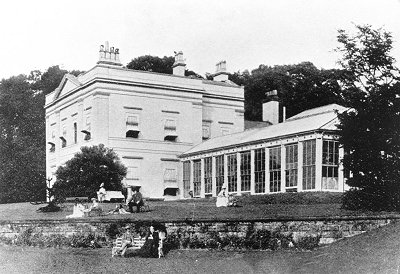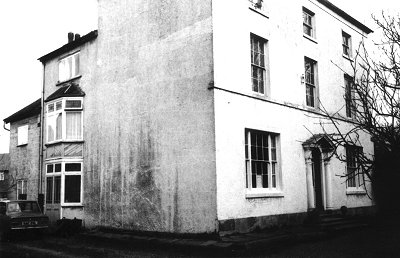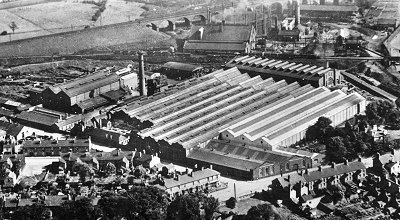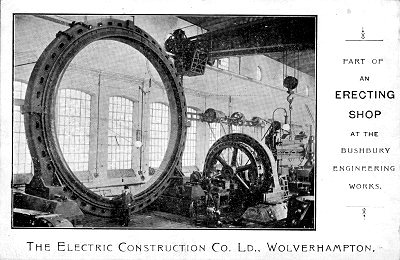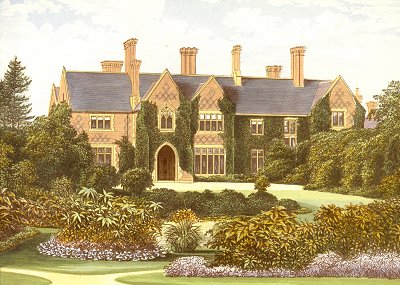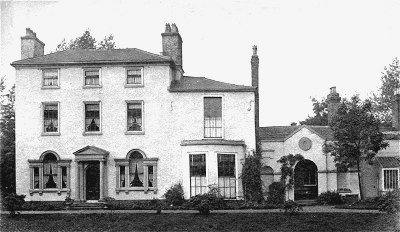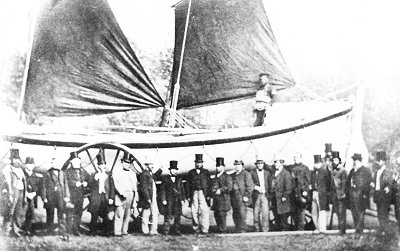BUSHBURY IN THE NINETEENTH CENTURYThe population of Bushbury At the time of the first census in 1801 the population of Bushbury was only 488 plus a further 369 in Essington, but according to the Poor Relief figures for 1803 four hundred and twenty people, i.e. nearly half the population, were receiving relief of some sort. The population of the parish was therefore not very much larger than at the time of the Hearth Tax in 1666. By 1851 there were 988 people in Bushbury and a further 644 at Essington, but by 1901 the population of the parish had grown to over four thousand. This was due in the main to the coming of the railways in the middle of the century, the expansion of coal-mining at Essington, and manufacturing industry in the extreme south of the parish towards the end of the century. Census Returns 1841 -1871
The coming of the railway The first railway through the parish was the Grand Junction line from Birmingham to Warrington. It entered the parish near Showell Manor in the south, and much of its original construction can still be seen, particularly the bridges over Showell Road, Bee Lane and Greenfield Lane. The end of Church Road was turned into Three Tuns Lane to obviate the need for an extra bridge, but the old fork in the road can still be seen at the bottom of Elston Hall Lane. Passenger train services started in July 1837 and the nearest station was at Heath Town (for Wolverhampton). Within ten years it was obvious that a station in Wolverhampton was essential, and this was one of the reasons for the promotion of the Stour Valley line from Birmingham (New Street) through Dudley Port. A station at Wolverhampton, known as Queen Street until 1885 was built, and the new line joined the Grand Junction at Bushbury, Stour Valley Junction. It opened for Goods Traffic in February 1852, and for passengers five months later. We can only imagine what life in the parish must have been like during those twenty years with hundreds of labourers working on the construction of the railway and all its necessary embankments, bridges etc.. Bushbury Station was opened to passengers on August 2nd 1852. It was situated between the two main lines at the junction and was approached by a footpath from the road bridge in Bushbury Lane behind the signal box. For a few years most express trains travelled over the Grand Junction Line from Birmingham to Stafford, and passengers to or from Wolverhampton had to change at Bushbury. One unhappy traveller was Catherine Booth, wife of the founder of the Salvation Army. In a letter to her mother dated May 31st 1857 she describes how late one evening she waited at Wolverhampton for a train to Stafford, "At a quarter past eleven o'clock we set off for Stafford. We had not gone two miles before we had to change carriages again, heaving all the luggage out in the dark etc. However, through mercy we got here at last." Another traveller through the parish about this time was Her Majesty Queen Victoria, on her journeys to and from Gosport and Scotland. On September 17th 1860 she travelled south, her train being transferred from the L.N.W. system at Bushbury via Cannock Road Junction to the Great Western Railway. On August 24th 1861 she travelled north again by the same route, the L.N.W. locomotive taking over at the Low Level station. She is said to have enquired who lived in the house overlooking the railway from the hill at Bushbury, now known to be Low Hill House.
In his book "Engine Driving Life or Stirring Adventures and Incidents in the Lives of Loco Engine Drivers" (written at Standeford in 1882 and dedicated to William Stroudley of the L.B.S.C. Railway), he tells of one unfortunate youth, Littleton Carless of Slade Heath, who was employed at Bushbury Sheds as a bar-boy. This work entailed entering the still hot firebox of a locomotive after it had finished its duty to scrape and brush the firebars free of ash. He walked the three and a half miles to work on alternate weeks for day and night shifts. One windy night he was opening the shed doors to allow a locomotive to enter and was crushed to death as the door was blown back against the engine. He was buried at Coven on December 27th 1870 aged 15. The first engine sheds were built about 1860 and accommodated about twelve locomotives. The row of "Railway Cottages" in Fordhouse Road, (demolished about 1970) date from this time. By 1874 the shed accommodation was inadequate as there were twenty seven engines using the shed, but it was not until 1882 that approval was given to enlarge the shed. A larger turntable was installed in the sidings behind the Railway Cottages in 1905, to replace a smaller one situated alongside the shed. This followed the decision that the Euston to Birmingham expresses should run through to Wolverhampton and that the engines should be stationed at Bushbury. The driver's Lodge, which stood on Bushbury Lane between Fordhouse Road and the bridge, was built to provide overnight accommodation for engine crews working a "double-home" turn. These were principally London men from Camden shed. In the same way Bushbury men stayed overnight in London. It seems likely that the gangs of "navigators" who built the various extensions to the sheds and sidings were encamped on the field on the west side of Fordhouse Road behind the driver's Lodge, as this area was still littered with pieces of Victorian pottery and churchwarden pipe in the 1930s. Another visible reminder of the railway development was the huge hole in the ground on the west side of Wood Lane between the Pumping engine cottages and the U.S.A.M. steelworks, where earth had been removed to make the "Shunting Hump". Known as Derby Joe's Hole, it was filled in only in the 1960s. By 1854 a railway was planned through the area. The Cannock branch of the South Staffordshire Railway at Walsall opened in 1858, and within a few years became a part of the London and North Western system. There were sidings at Norton Cannock Colliery near the northern boundary of the parish. A plan to construct a "Cannock Chase" branch from the L.N.W.R. at Cannock Road Wolverhampton through Essington was in being as late as the First World War, but the line was never built. All these developments in the railway system meant that more and more families settled in the Parish, principally in the Bushbury Lane and Shaw Road area where new houses were built in the 1870s and 80s, followed by Showell Road in the 1890s. Although the Great Western works and sheds at Stafford Road were outside the parish, many of their employees came to live in Bushbury, and the parish became very much a community of railwaymen. Agriculture and Other Industries Although the coming of the railways had changed the parish in many ways, most of the land was still under agriculture. The farmers of the parish had their annual Agricultural Show, and some of the details for 1858 have survived. It was held on Friday October 22nd at the "Three Tuns" inn Oxley, and there were prizes for horses, cattle, sheep and pigs. A Ploughing Competition was held on the Wobaston and Three Tuns farms, and upward of £225 was given in prizes. The medal awarded for the best breeding sow was found on a beach in New Zealand in 1979; it had been presented to Mr. W.H. Davies of Harrington. (This was probabably the village of that name in Northamptonshire. There are other villages of that name in Lincolnshire and Cumberland, but only the Northamptonshire village would have had easy access to Bushbury on the railway system of that time.)
The 6" Ordnance Survey map of the 1880s shows eight working collieries, Holly Bank, (the largest), Essington Wood, Essington Farm, Hilton Colliery No. 2 (not Hilton Main), Springhill, Cannock Lodge, Norton Cannock and Sneyd House, as well as twenty four "old shafts", "disused collieries" etc.
Social Life and Events In the ten years 1879-89 the Church of England opened four new chapels or mission rooms to provide for these new residents.
Quite early in the century many of the old landowning families moved away, tending to let their houses and land to industrialists who wished to live away from the developing Black Country, or to tenant farmers. The Hortons moved to Worcester before 1820, the Whitgreaves spent more time in London and later Leamington, and the Goughs left Oldfallings for Perry Hall and London. Incoming families such as the Perrys, the Mannix's, followed by the Tarratts and Nathaniel Neal Solly of the Wednesbury iron founding family, were at Moseley Hall. The Wiggins were tenant farmers at Moseley Old Hall, John Moreton was at Moseley Court after the Whitgreaves left in the 1860s, (although they did return for a time in the 1890s), and the Briscoes at Old Fallings from about 1820. Most of these incoming families seem to have become involved in the life of the parish, replacing people whose forebears had owned the land and influenced life in the parish for the previous two or three centuries. Gorsebrook House About 1900 Gorsebrook House was the home of Mr.Jones, the first Works Manager of the Electric Construction Co. From about 1840 until the 1860s the house was occupied by Richard Gough and his family. (As far as I know, not connected with the Goughs of Old Fallings.)
A third generation John Corser was educated at Rugby and Trinity College Cambridge. He took Holy Orders and was for a time curate of Dunchurch, Warwicks. He died at 6 The Terrace, Blackheath on March 9th 1886 aged 79.
Crime and Punishment Wolverhampton Chronicle November 7th. 1832:
Alexander Hordern of Oxley Manor, giving evidence on the behaviour of canal boatmen to the "Select Committee on Sunday Trading" 1841 (109& 175/6):
Wolverhampton Chronicle September 20th 1826:
Wolverhampton Chronicle April 23rd 1817:
Bushbury Burial Register August 6th 1826:
With two other men, Adams and Bosworth, John Williams had been convicted at Stafford Assizes of assaulting and robbing Edward Ridley as he was returning to Pattingham from Wolverhampton. (Wolverhampton Chronicle July 26th and August 9th 1826.) The "Wolverhampton" Lifeboat The "Wolverhampton" lifeboat was paid for by public subscription in the town, built by Messrs. Forrest of Limehouse and brought to Wolverhampton without charge by the Great Western Railway Co. 33 feet long, eight feet wide with ten oars double banked as well as masts and sails, she was built with a keel weighing 6 hundredweights, two airtight compartments fore and aft and 9.5 hundredweight of cork between keel and deck. Cost with equipment was £325 plus a further £95 for the carriage. After standing for several days outside the "Deanery", on the morning of Monday August 25th, pulled by teams of volunteers she set off on a tour of the town centre and then down the Stafford Road to Bushbury Pool, or Showell Pool as it was then known. After being formally handed over to the Royal National Lifeboat Institution and being accepted by Captain Robertson R.N. the vessel was launched to the sound of "The Death of Nelson" in pouring rain.
The "Wolverhampton" saved many lives in the Bristol Channel until it was lost in a storm in 1883 off the Mumbles. |
